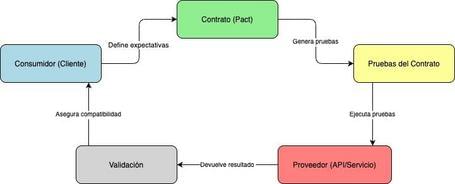We’re kicking off the next installment of our series on microservice architecture patterns. As in previous articles, here are the posts we've already published, just in case you missed any and want to dive deeper into the microservice architecture patterns we've already explored:
- Microservices Architecture Patterns: What Are They and What Benefits Do They Offer?
- Architecture Patterns: Organization and Structure of Microservices.
- Architecture Patterns: Microservices Communication and Coordination.
- Microservices Architecture Patterns: SAGA, API Gateway, and Service Discovery.
- Microservices Architecture Patterns: Event Sourcing and Event-Driven Architecture (EDA).
- Microservices Architecture Patterns: Communication and Coordination with CQRS, BFF, and Outbox.
- Microservices Patterns: Scalability and Resource Management with Auto Scaling.
- Architecture Patterns: From Monolith to Microservices.
- Externalized Configuration.
In today’s architectures, the increasing demand for frequent deployments has pushed teams and organizations toward distributed models, where each service plays a specific role within the platform. However, this freedom also introduces new challenges when evolving APIs without breaking dependent services.
To address this issue, we have the microservices architecture pattern known as Consumer-Driven Contract Testing (CDCT), which we’ll explore in the following ways:
- How to ensure compatibility between services despite constant API evolution.
- The consumer’s role in defining contracts and automated verification in the provider’s pipeline.
- Using tools like Pact or Spring Cloud Contract to orchestrate contract tests in CI/CD environments.

Here we see a visual diagram of the Consumer-Driven Contract Testing (CDCT) process. It illustrates how a consumer defines expectations in a contract (Pact), which is then used to generate tests that are executed against the provider (API/Service). The test results validate whether the contract is still being honored.
Note: Code examples are provided solely for conceptual understanding.
Challenges in a microservices environment with evolving APIs
A service may change the format of its response or add new fields to support business functionality.
If another microservice consumes that API and isn’t aware of the modification, this can lead to production errors.
Maintaining integration tests that cover the entire ecosystem is often costly and not always agile.
Consumer-Driven Contract Testing (CDCT)
Context and motivation
In a microservices architecture, it’s common for service A (the consumer) to require data or actions from service B (the provider).
For example, orders-service calls payment-service to process a payment, and it returns a JSON with the transaction status. If payment-service changes that JSON format (e.g., replacing confirmationUrl with confirmLink), orders-service could break because it’s expecting a specific field.
Traditional integration tests (end-to-end) address this by spinning up all services at once and verifying the interaction. But this approach is expensive in terms of time, infrastructure, and coordination, especially when dealing with dozens or hundreds of microservices.
Consumer-Driven Contract Testing offers a more lightweight and scalable alternative:
- The consumer defines a contract that describes the requests and responses it expects from each provider endpoint.
- The provider automatically verifies this contract in its CI/CD pipeline to ensure it doesn’t introduce breaking changes.
CDCT Principles
- Consumer-driven contracts:
- The consumer knows exactly which parts of the response it uses and in what format.
- This avoids testing unnecessary aspects from the provider side.
- Contract versioning and publishing:
- Contracts are stored in a broker (e.g., Pact Broker) or in Git repositories.
- They’re versioned, allowing consumers and providers to evolve in sync. A consumer may say: “I need version 2 of the contract that defines confirmLink instead of confirmationUrl.”
- Continuous integration:
- Every change in the provider (new microservice version) validates against the contracts published by consumers.
- If something breaks, the pipeline fails before reaching production.
- Team collaboration:
- Teams define their expectations (contracts) and agree on API evolution.
- Conflicts are resolved during development, not in production.
Tools and approaches
Pact
- Cross-platform library (supports Java, JavaScript, .NET, Python, etc.).
- Generates pact files that describe consumer-expected interactions.
- Includes a “Pact Broker” to publish and version contracts, plus plugins to integrate with pipelines.
Spring Cloud Contract
- Geared toward Java/Spring Boot projects.
- Contracts can be written in Groovy or YAML. It generates server stubs and automatically verifies interactions.
- Ideal for teams working primarily with the Spring ecosystem.
Dredd
- Based on OpenAPI/Swagger.
- Compares actual API requests/responses with the OpenAPI spec, validating conformance.
- Useful if your API is already defined in Swagger and you want to verify that implementation matches the spec.
Microcks, Hoverfly, Mountebank
- Provide service virtualization and contract validation features.
- More commonly used for service mocking in integration tests rather than pure CDCT.
Practical example
Let’s look at a real-world case where orders-service consumes the /pay endpoint of payment-service.
The business scenario is: the user confirms an order, orders-service calls payment-service with a JSON body that includes the total amount, order ID, payment method, etc. payment-service responds with a payment ID (paymentId), a status (APPROVED, DECLINED), and a confirmation URL.
Defining the contract in the consumer
In orders-service, we write a contract test using Pact. Suppose we’re using JUnit + Pact-JVM. This can be done in Java or Groovy.
Here’s a simplified Java example:
@ExtendWith(SpringExtension.class)
@PactTestFor(providerName = "payment-service", port = "8080")
class PaymentContractTest {
@Pact(consumer = "orders-service", provider = "payment-service")
public RequestResponsePact createPaymentPact(PactDslWithProvider builder) {
return builder
.uponReceiving("A request to create a payment")
.path("/pay")
.method("POST")
.body("{\"orderId\":1234,\"amount\":99.90,\"method\":\"CREDIT_CARD\"}")
.willRespondWith()
.status(200)
.body("{\"paymentId\":\"abc-123\",\"status\":\"APPROVED\",\"confirmationUrl\":\"https://payments.example.com/confirm/abc-123\"}")
.toPact();
}
@Test
@PactTestFor(pactMethod = "createPaymentPact")
void verifyCreatePaymentPact(MockServer mockServer) {
RestTemplate restTemplate = new RestTemplate();
Map<String, Object> request = new HashMap<>();
request.put("orderId", 1234);
request.put("amount", 99.90);
request.put("method", "CREDIT_CARD");
ResponseEntity<Map> response = restTemplate.postForEntity(
"http://localhost:" + mockServer.getPort() + "/pay",
request,
Map.class
);
assertEquals(200, response.getStatusCodeValue());
assertEquals("APPROVED", response.getBody().get("status"));
assertTrue(response.getBody().containsKey("confirmationUrl"));
}
}
When running this test in orders-service, Pact generates a .json file (the pact file) that describes the interaction:
{
"provider": {
"name": "payment-service"
},
"consumer": {
"name": "orders-service"
},
"interactions": [
{
"description": "A request to create a payment",
"request": {
"method": "POST",
"path": "/pay",
"body": {
"orderId": 1234,
"amount": 99.90,
"method": "CREDIT_CARD"
}
},
"response": {
"status": 200,
"body": {
"paymentId": "abc-123",
"status": "APPROVED",
"confirmationUrl": "https://payments.example.com/confirm/abc-123"
}
}
}
]
}
This file can be published to a Pact Broker using a Gradle/Maven script that uploads it during the post-test phase. We can associate it with the specific version of the consumer (e.g., orders-service v1.3.0).
Contract verification on the provider side
On the other hand, payment-service (the provider) integrates a step in its pipeline to download the latest pact file from the broker and execute it against its real or simulated implementation. Let’s say we have a test called PaymentProviderTest that launches the actual application on a random port and has Pact replicate the interaction.
In Groovy:
class PaymentProviderTest extends Specification {
@Shared
@AutoStart // Assume an extension that initiates the paid service
ApplicationUnderTest paymentApp = new PaymentAppUnderTest()
@PactVerification(provider = "payment-service", consumer = "orders-service")
def "should validate the pact with the ordering service"() {
// No need to write logic, Pact takes care of triggering the interaction
expect:
// Pact will validate the request and the actual response
true
}
}
The verification will check that when calling POST /pay with that body, payment-service returns paymentId, status, and confirmationUrl exactly as defined.
If any attribute differs (for example, the service changed confirmationUrl → link), the verification will fail, and the build will not continue.
This way, the payment-service team is immediately notified that their planned change would break orders-service expectations, allowing them to negotiate or version the API before causing a production failure.
Integration into CI/CD pipelines
- orders-service build:
- Runs unit and contract tests.
- If successful, generates the pact file and publishes it to the broker with the master tag or the consumer version.
- payment-service build:
- Downloads pact files from its consumers (orders-service, and possibly others) from the broker.
- Runs verification against its local implementation.
- If everything passes, the provider version is “tagged” as compatible with version X of orders-service.
- Proceeds with deployment to higher environments. If it fails, the pipeline stops.
This methodology extends to all services depending on payment-service, ensuring none of them break due to unexpected changes.
What are the benefits?
- Early detection of breaking changes: providers are instantly notified if a change breaks a consumer.
- Fewer dependencies in testing: there’s no need to spin up the full microservice environment to check compatibility.
- Living documentation: contracts act as the real specification of what each consumer expects, improving cross-team communication.
- Alignment with independent deployments: each microservice can evolve without fear of introducing unintended breaking changes.
Recommended best practices
- Adopt a “Secure by Design” mindset: when dealing with externalized configuration, especially protect sensitive data using Vault, Kubernetes Secrets, or strong encryption.
- Version your APIs: CDCT does not eliminate the need to version endpoints when introducing major changes. For example, maintain /v1/pay and /v2/pay in payment-service, allowing consumers to migrate progressively.
- Keep communication open between teams: the success of CDCT depends on collaboration. It’s not a replacement for communication but a catalyst to discuss contracts objectively.
- Automate the pipeline: both configuration retrieval and contract verification should run in every build, not just before a release.
Advanced scenarios
- Multi-Broker: in large organizations, there may be multiple Pact Brokers or contract repositories. Make sure to unify your publishing and versioning strategy to avoid chaos.
- Polyglot microservices: if your platform includes services written in Java, Node.js, Python, etc., be sure to choose CDCT tools that support multiple languages (Pact is quite flexible here).
- Contract-first testing: some teams define the contract first and generate stubs so consumers can develop against them. Others take a consumer-first approach. Both strategies can coexist and complement each other.
Conclusions and next steps
With Consumer-Driven Contract Testing, we anticipate API breakages, promote collaboration between development teams, and avoid costly production incidents.
It empowers consumers to define their contract, which is then continuously validated in the provider’s pipeline, preventing last-minute surprises in production and strengthening team collaboration. Plus, tools like Pact, Spring Cloud Contract, and Dredd make adoption easier.
If you're concerned about API breakages and have already experienced production incidents, start by documenting the main interactions between your services. Define one or two contracts using the CDCT approach and configure the provider’s pipeline. You’ll see how issues get caught before they reach your users.
A robust microservice also needs well-designed logs, distributed tracing (observability), and resilience mechanisms (circuit breakers, timeouts). CDCT isn’t a standalone solution, it complements your broader DevOps/Cloud Native strategy.
In future posts, we’ll dive deeper into topics like security patterns, fault tolerance, monitoring, and observability, essential for operating a large-scale microservice platform that meets high performance and compliance demands.
Comments are moderated and will only be visible if they add to the discussion in a constructive way. If you disagree with a point, please, be polite.








Tell us what you think.